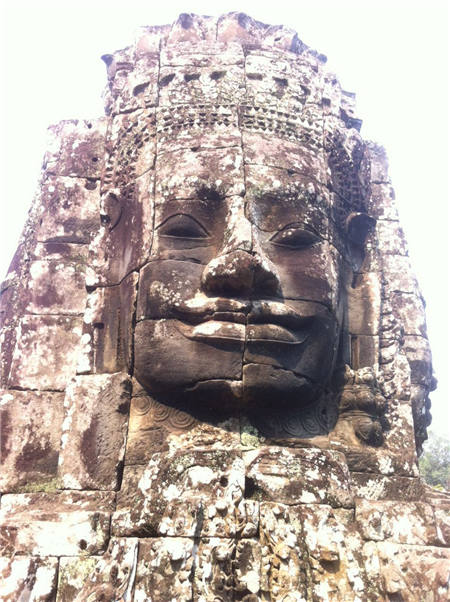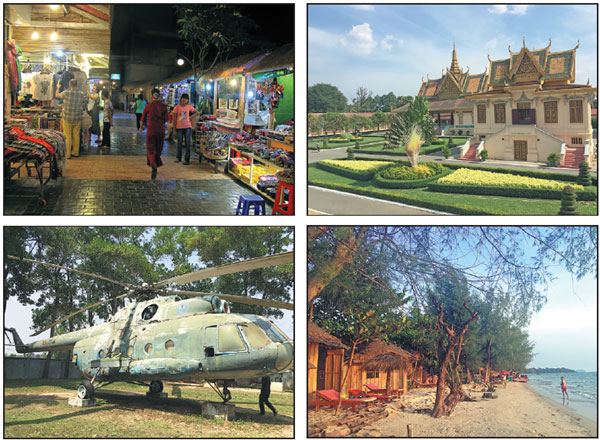Going beyond Angkor Wat
|
Clockwise from top left: The night market in Siem Reap is the place to find souvenirs and local handicrafts; inside the Royal Palace in the capital, Phnom Phen; Otres beach in Sihanoukville offers a calm, laid-back experience; a relic of the Cambodian civil war, one of many on display at the War Museum. |
Most are located within two circuits to the north, both of which take a good 10 hours to cover, either starting at sunrise or finishing at sunset. Those in town for only a day or two will probably be content with the smaller of the two, which includes Angkor Wat and Bayon. However, if you do have the time, doing both circuits and adding a third day to see sites further out, such as the 1,000 year-old Banteay Srei or the jungle-covered Beng Melea, is well worth it to see the variations in carving styles and architecture.
Trips to temples further out can also be combined with other activities, such as a visit to the Landmine Museum ($5), which raises awareness and money for families affected by landmines, and Bantreay Srei Butterfly Park ($4).
For those interested in learning about Cambodia's recent history, the War Museum ($5), not far from the city center, features a comprehensive collection of weaponry and photos from the civil war. Guides offer free tours and most themselves are former soldiers who can regale visitors with firsthand accounts of the conflict.
Just to the south of Siem Reap is the vast Tonle Sap Lake, which is surrounded by floating villages and boasts abundant wildlife.
Chong Khneas, a small fishing community, is probably the most popular among tourists, but you can escape the crowds by heading out early to Kampong Phluk. In the dry season (November to April), you can see the tall stilts that support the houses, offering an otherworldly experience. When the rain arrives, travel here can be accomplished only by boat.
After a tiring tour in Siem Reap's beautiful wilderness, you'll be spoiled for choice on where to unwind. Most of the city's nightlife is spread between three areas - Old Market, Wat Damnak and Wat Bo - and all have an abundance of bars, restaurants, markets, and massage parlors.
The only downside is that you may never want to leave.
Contact the writer at craig@chinadaily.com.cn
Things to know
 |
|
An example of the ancient statues that can be found throughout the Angkor Wat Archeological Park. |
Money: The riel is the official currency of Cambodia, but US dollars are more commonly used by businesses, even in the markets. Riel is generally used for only small purchases. ATMs accept most bankcards, including Union Pay. Check your change, though, as stores and restaurants will not accept notes that are even slightly ripped, nor can you use $2 notes.
Visas: Landing visas for tourists cost $30 per person at custom entry points in Phnom Penh and Siem Reap. Try to fill out the paperwork on the plane to save time, and if possible pay with the exact money.
Scams: Be wary of staff members inside temples who demand an extra fee to enter "closed-off" sections; more often than not they are the ones who closed off that section. Also, the people casually offering incense near statues will expect money if you take it off them.
NGOs, orphanages: There are many ways in which tourists can contribute to aid organizations, such as buying from stores that support impoverished families, eating at restaurants that help vulnerable young adults, or donating blood. However, carefully research any orphanage you plan to visit, as some are scams using children to profit from the so-called pity industry.















